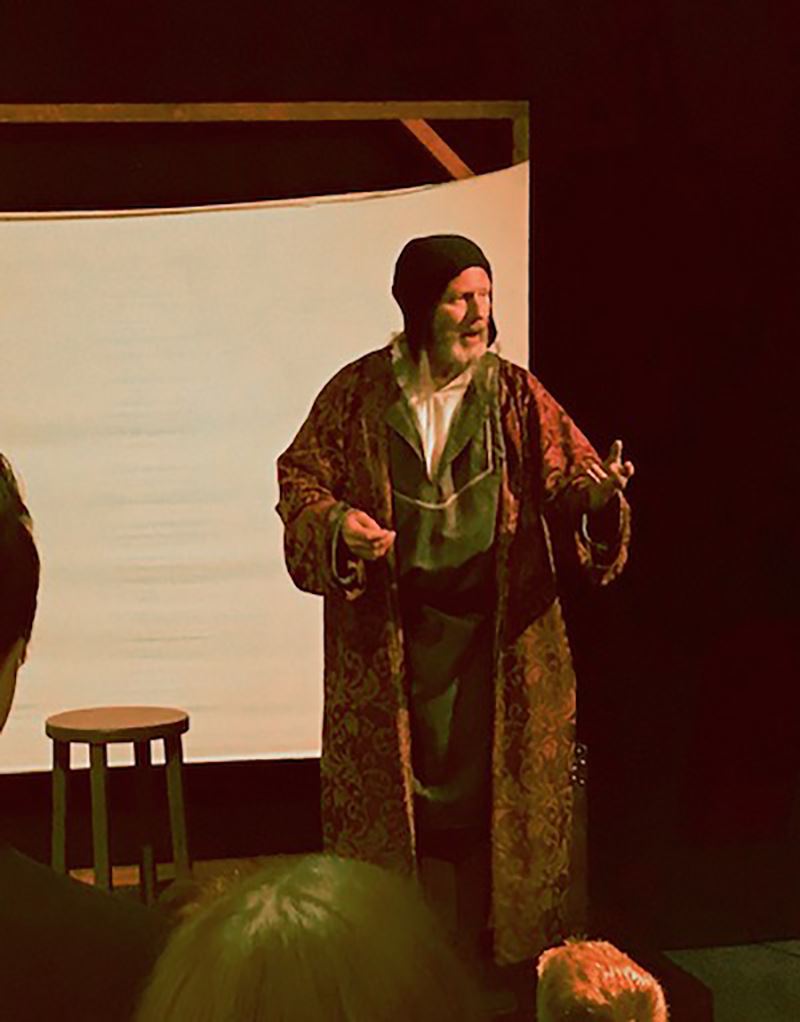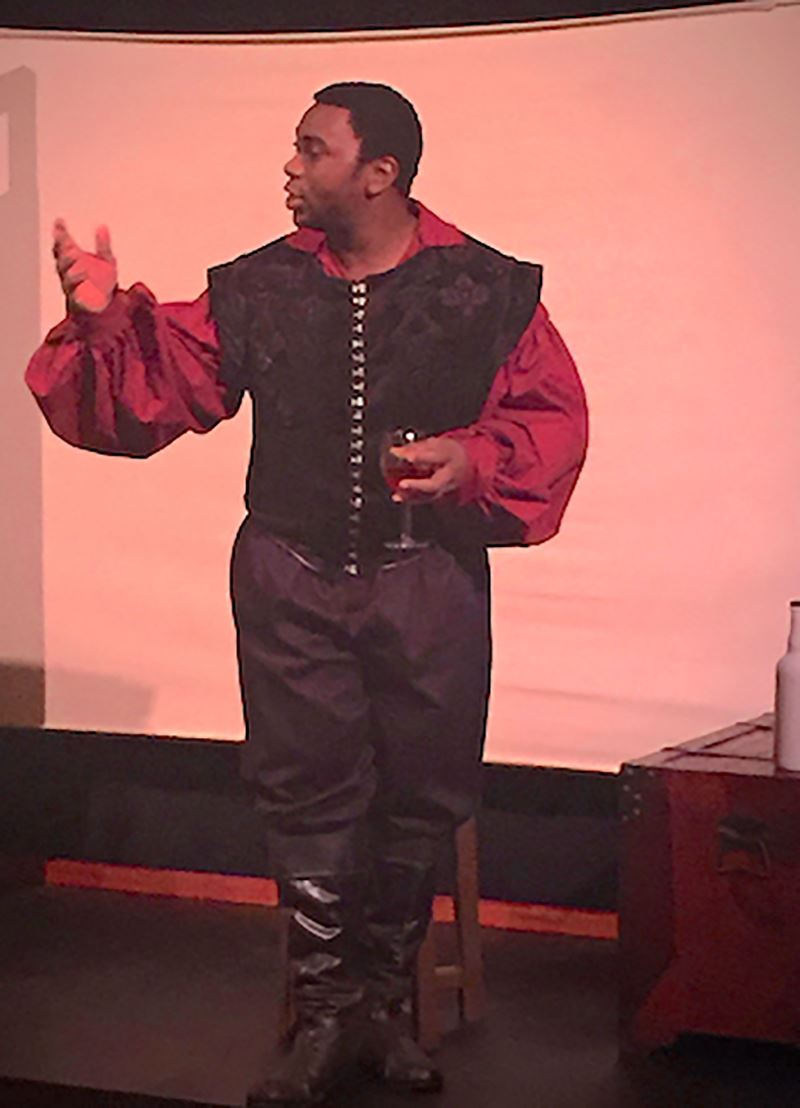 Six Characters
Six Characters
Discovering da Vinci
By Douglas Coler
When I was told that Discovery Place Science would host Da Vinci’s Machines (on exhibit November 2017 to May 2018) I was hopeful for the theatrical possibilities that it presented.
Da Vinci’s Machines is a 5,000+ square foot exhibition that features recreations of some the designs in Leonardo da Vinci’s surviving notebooks. Some are full sized (a self-propelled cart, and theatrical knights automata) , most are scale models of machines da Vinci designed but, as far as is known, never built (his battle tank, his diving apparatus, his flying machines). Scattered among them are copies of his most famous paintings and drawings (The Last Supper, Mona Lisa, Lady with an Ermine, Madonna of the Rocks, and others).
I initially wanted to present Jon Lipsky’s The Masque of Leonardo, written for a da Vinci exhibit at Boston’s Museum of Science in the early 1990’s. I’d read the piece, posted on his web site and made available royalty-free by his estate, and for a time, I considered it an ideal companion to the exhibition. It is a challenging, beautifully written short play that our adult audience would very much appreciate. It also calls for a bit more technical support the I had personnel for, so we put it aside in favor of monologues.
We’d had a notable success with this model at Discovery Place Science with Van Gogh Alive!, 101 Inventions That Changed The World, A Day in Pompeii, Guitar, and Shipwreck: Pirates and Treasure. Most of those were done with contracted actors or educator staff, however. Last January, DPS decided to hire InterActors, a part -time staff dedicated solely to theatrical interpretation. That team of four - Christian Payne, Devin Walker, Adaline Pann, and Philip Robertson - present scripted programs throughout the museum, in galleries, in labs, in lobbies, in our Discovery Theatre, and at civic events, and in our traveling exhibitions hall.
 I assigned Hannah Simmons, a theatrically trained Educator who has written many of our programs, to find suitable characters for our InterActors to portray in the exhibit. Hannah’s great gift is her ability to, in a short amount of time, distill her research into compelling monologues. We prefer, when possible, to present the actual person and not a composite character, so Hannah and I settled on some historic figures fairly quickly. We knew we’d have Leonardo himself. We settled on Ludovico Sforza, da Vinci’s great patron in Milan, the man who commissioned The Last Supper; Michelangelo, his young, talented, arrogant rival; Pope Leo X, who housed da Vinci at the Vatican; Alessandro de Medici, the last hereditary Duke of Florence, grandson of Lorenzo the Magnificent and who as a boy, was privileged to watch da Vinci at work for his father, and Bianca Sforza, niece of Ludovico, future Holy Roman Empress, and subject of the drawing known as la bella Principessa.
I assigned Hannah Simmons, a theatrically trained Educator who has written many of our programs, to find suitable characters for our InterActors to portray in the exhibit. Hannah’s great gift is her ability to, in a short amount of time, distill her research into compelling monologues. We prefer, when possible, to present the actual person and not a composite character, so Hannah and I settled on some historic figures fairly quickly. We knew we’d have Leonardo himself. We settled on Ludovico Sforza, da Vinci’s great patron in Milan, the man who commissioned The Last Supper; Michelangelo, his young, talented, arrogant rival; Pope Leo X, who housed da Vinci at the Vatican; Alessandro de Medici, the last hereditary Duke of Florence, grandson of Lorenzo the Magnificent and who as a boy, was privileged to watch da Vinci at work for his father, and Bianca Sforza, niece of Ludovico, future Holy Roman Empress, and subject of the drawing known as la bella Principessa.
Composite characters work very well in most cases, particularly if you have them interacting for more than ten or twenty minutes at a time. We did consider this approach, but given that our InterActors have other shows to perform throughout the day, we opted for a set schedule of three monologues, one each at 11 am, 1pm, and 3 pm. If a particular InterActor had some clear time before their next, non-da Vinci show, they could opt to mingle in the exhibit after delivering the monologue.
Our Exhibits team built us a small stage, and to keep the aesthetic consistent, we used the spare wood and canvas dividers from the exhibit as our back drop. This also serves as a projection space for a fifteen minute documentary that plays on a loop between performances. The InterActors control lighting and sound before their entrance from backstage, and reset the film at the conclusion of their monologue. The stage is situated at the second ‘turn’ in the hall, which allows for seating space and standing room for around 50 people.
The rehearsals were undertaken a few weeks before opening. We are usually time constrained, as the InterActors are limited in their weekly hours and must still perform the other programs for which they were engaged, so rehearsals were a scattershot affair, but as all are monologues, it was easy enough to catch time and get every one sufficiently prepped. The InterActors are also required to continue reading and research for the duration of the exhibit’s stay. In addition to the four InterActors, we have a talented volunteer docent with a museum interpretation background, Christopher Emerson, who joins the team as Pope Leo X. Chris also wrote much of his own material.
We’ve kept the costuming simple, favoring a suggestion of Renaissance clothing as opposed to detailed recreations, which were beyond our budget. Hand props are simple (a bird’s wing, scrolls, a book, a bottle and wine glass, an embroidery hoop, sculpting tools). A small plain stool and wooden trunk sit on the stage and serve for all settings and time periods.
All the actors have Italian phrases sprinkled throughout their material. As Leonardo, I affect a slight modern Italian accent, which gives a sense of ‘otherness’ without overpowering the story. Michelangelo, too, adopts such an accent, but the absence of an accent for some does not seem to disturb our audience.
Audiences have responded enthusiastically. We’ve found that while many of our audience do want to see Leonardo in particular, they are surprised and delighted to find themselves in the presence of the Dukes, the Pope, the young Empress, and the hot-headed Michelangelo, who spends a good part of his time questioning the talent and reputation of da Vinci. (Leonardo, in turn, decries Michelangelo and his ilk, who declare passion as their guide and hold study and practice in low regard.) The six characters offer the visitor a chance to see different sides to the man da Vinci was, and how those contemporary views differ from, but also inform and enlighten our opinions and knowledge of him some 500 years later. 
This article can be found in Winter 2018 - "Finding the Story: Creative and Collaborative Processes" (Volume 28, Issue 1) of IMTAL Insights.
![]()
![]()
![]()
ABOUT THE AUTHOR:
 Douglas Coler is Coordinator, Shows and Floor Programming, at Discovery Place Science. In this capacity, he oversees the InterActors and the writing and production of programming at The Discovery Theatre, The Stage, The Rain Forest Theatre, and on-floor interactive demonstrations, as well as support programming for traveling exhibitions. He joined Discovery Place in 2008 as Presenter, and has also served as Dramatic Programming Specialist prior to assuming his current duties. He was an Associate Director for the national touring company Chamber Theatre Productions, and has served as Guest Director at Stonehill College in Easton, MA. He serves as Discovery Place’s representative with NISEnet (The National Informal Science Education Network), and is the current president of IMTAL.
Douglas Coler is Coordinator, Shows and Floor Programming, at Discovery Place Science. In this capacity, he oversees the InterActors and the writing and production of programming at The Discovery Theatre, The Stage, The Rain Forest Theatre, and on-floor interactive demonstrations, as well as support programming for traveling exhibitions. He joined Discovery Place in 2008 as Presenter, and has also served as Dramatic Programming Specialist prior to assuming his current duties. He was an Associate Director for the national touring company Chamber Theatre Productions, and has served as Guest Director at Stonehill College in Easton, MA. He serves as Discovery Place’s representative with NISEnet (The National Informal Science Education Network), and is the current president of IMTAL.